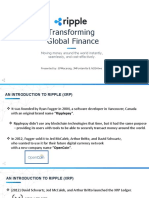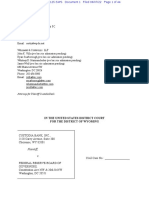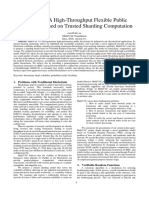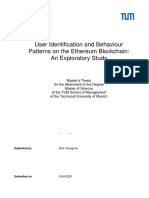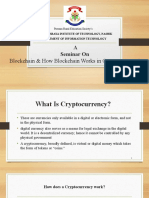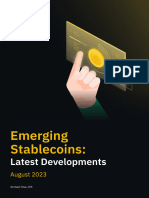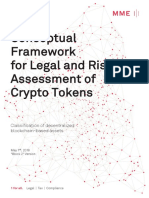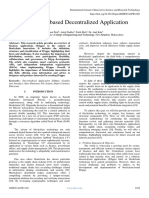Side Chains
Side Chains
Uploaded by
MichaelPatrickMcSweeneyCopyright:
Available Formats
Side Chains
Side Chains
Uploaded by
MichaelPatrickMcSweeneyOriginal Description:
Copyright
Available Formats
Share this document
Did you find this document useful?
Is this content inappropriate?
Copyright:
Available Formats
Side Chains
Side Chains
Uploaded by
MichaelPatrickMcSweeneyCopyright:
Available Formats
Enabling Blockchain Innovations with Pegged Sidechains
Adam Back, Matt Corallo, Luke Dashjr,
Mark Friedenbach, Gregory Maxwell,
Andrew Miller, Andrew Poelstra,
Jorge Timn, and Pieter Wuille
2014-10-22 (commit 5620e43)
Abstract
Since the introduction of Bitcoin[Nak09] in 2009, and the multiple computer science
and electronic cash innovations it brought, there has been great interest in the potential of
decentralised cryptocurrencies. At the same time, implementation changes to the consensus-
critical parts of Bitcoin must necessarily be handled very conservatively. As a result, Bitcoin has
greater difculty than other Internet protocols in adapting to new demands and accommodating
new innovation.
We propose a new technology, pegged sidechains, which enables bitcoins and other ledger
assets to be transferred between multiple blockchains. This gives users access to new and
innovative cryptocurrency systems using the assets they already own. By reusing Bitcoins
currency, these systems can more easily interoperate with each other and with Bitcoin, avoiding
the liquidity shortages and market uctuations associated with new currencies. Since sidechains
are separate systems, technical and economic innovation is not hindered. Despite bidirectional
transferability between Bitcoin and pegged sidechains, they are isolated: in the case of a
cryptographic break (or malicious design) in a sidechain, the damage is entirely conned to
the sidechain itself.
This paper lays out pegged sidechains, their implementation requirements, and the work
needed to fully benet from the future of interconnected blockchains.
adam@cypherspace.org, mattc@bluematt.me, luke@dashjr.org, mark@friedenbach.org,
greg@xiph.org, amiller@cs.umd.edu, apoelstra@wpsoftware.net, jtimon@jtimon.cc,
pieter.wuille@gmail.com
This work was partially supported by Blockstream, a company founded by several of the authors. Many of the concepts
discussed in this paper were developed before Blockstream existed; sidechain technology is an open proposal by the authors
themselves.
1
Contents
1 Introduction 3
2 Design rationale 7
3 Two-way peg 8
3.1 Denitions . . . . . . . . . . . . . . . . . . . . . . . . . . . . . . . . . . . . . . . 8
3.2 Symmetric two-way peg . . . . . . . . . . . . . . . . . . . . . . . . . . . . . . . 9
3.3 Asymmetric two-way peg . . . . . . . . . . . . . . . . . . . . . . . . . . . . . . . 11
4 Drawbacks 11
4.1 Complexity . . . . . . . . . . . . . . . . . . . . . . . . . . . . . . . . . . . . . . 11
4.2 Fraudulent transfers . . . . . . . . . . . . . . . . . . . . . . . . . . . . . . . . . . 12
4.3 Risk of centralisation of mining . . . . . . . . . . . . . . . . . . . . . . . . . . . 12
4.4 Risk of soft-fork . . . . . . . . . . . . . . . . . . . . . . . . . . . . . . . . . . . . 13
5 Applications 14
5.1 Altchain experiments . . . . . . . . . . . . . . . . . . . . . . . . . . . . . . . . . 14
5.1.1 Technical experimentation . . . . . . . . . . . . . . . . . . . . . . . . . . 14
5.1.2 Economic experimentation . . . . . . . . . . . . . . . . . . . . . . . . . . 15
5.2 Issued assets . . . . . . . . . . . . . . . . . . . . . . . . . . . . . . . . . . . . . . 15
6 Future directions 16
6.1 Hashpower attack resistance . . . . . . . . . . . . . . . . . . . . . . . . . . . . . 16
7 Acknowledgements 17
A Federated peg 17
B Efcient SPV proofs 19
C Atomic swaps 21
License. This work is released into the public domain.
2
1 Introduction
David Chaum introduced digital cash as a research topic in 1983, in a setting with a central server
that is trusted to prevent double-spending[Cha83]. To mitigate the privacy risk to individuals from
this central trusted party, and to enforce fungibility, Chaum introduced the blind signature, which he
used to provide a cryptographic means to prevent linking of the central servers signatures (which
represent coins), while still allowing the central server to perform double-spend prevention. The
requirement for a central server became the Achilles heel of digital cash[Gri99]. While it is
possible to distribute this single point of failure by replacing the central servers signature with
a threshold signature of several signers, it is important for auditability that the signers be distinct
and identiable. This still leaves the system vulnerable to failure, since each signer can fail, or be 10
made to fail, one by one.
In January of 2009, Satoshi Nakamoto released the rst widely used implementation of peer-
to-peer trustless electronic cash[Nak09], replacing the central servers signature with a consensus
mechanism based on proof of work[Bac02], with economic incentives to act cooperatively.
Bitcoin tracks payments by aggregating them into blocks, each with an associated blockheader,
which cryptographically commits
1
to: the contents of the block, a timestamp, and the previous
blockheader. The commitments to previous headers form a blockchain, or chain, which provides a
well-dened ordering for transactions.
We observe that Bitcoins blockheaders can be regarded as an example of a dynamic-
membership multi-party signature (or DMMS), which we consider to be of independent interest as 20
a new type of group signature. Bitcoin provides the rst embodiment of such a signature, although
this has not appeared in the literature until now. A DMMS is a digital signature formed by a set of
signers which has no xed size. Bitcoins blockheaders are DMMSes because their proof-of-work
has the property that anyone can contribute with no enrolment process. Further, contribution is
weighted by computational power rather than one threshold signature contribution per party, which
allows anonymous membership without risk of a Sybil attack (when one party joins many times and
has disproportionate input into the signature). For this reason, the DMMS has also been described
as a solution to the Byzantine Generals Problem[AJK05].
Because the blocks are chained together, Bitcoins DMMS is cumulative: any chain (or chain
fragment) of blockheaders is also a DMMS on its rst block, with computational strength equal 30
to the sum of the strengths of the DMMSes it is composed of. Nakamotos key innovation is the
aforementioned use of a DMMS as a signature of computational power rather than a signature of
knowledge. Because signers prove computational work, rather than proving secret knowledge as
is typical for digital signatures, we refer to them as miners. To achieve stable consensus on the
blockchain history, economic incentives are provided where miners are rewarded with fees and
subsidies in the form of coins that are valuable only if the miners form a shared valid history,
incentivising them to behave honestly. Because the strength of Bitcoins cumulative DMMS is
directly proportional to the total computational power contributed by all miners[Poe14a], it becomes
1
A commitment is a cryptographic object which is computed from some secret data, but does not reveal it, such that the
data cannot be changed after the fact. An example of a commitment is a hash: given data x, one can publish H(x) where H
is a hash function, and only later reveal x. Veriers can then conrm that the revealed value is the same as the original value
by computing H(x) themselves.
3
infeasible for a computational minority to change the chain. If they try to revise the DMMS-secured
ledger, they will fall behind and be continually unable to catch up to the moving target of the 40
progressing consensus blockchain.
Because the miners do not form an identiable set, they cannot have discretion over the rules
determining transaction validity. Therefore, Bitcoins rules must be determined at the start of its
history, and new valid transaction forms cannot be added except with the agreement of every
network participant. Even with such an agreement, changes are difcult to deploy because they
require all participants to implement and execute the new rules in exactly the same way, including
edge cases and unexpected interactions with other features.
For this reason, Bitcoins objective is relatively simple: it is a blockchain supporting the
transfer of a single native digital asset, which is not redeemable for anything else. This allowed
many simplications in the implementation, but real-world demands are now challenging those 50
simplications. In particular, current innovation is focused around the following areas:
1. There are trade-offs between scalability and decentralisation. For example, a larger block
size would allow the network to support a higher transaction rate, at the cost of placing more
work on validators a centralisation risk.
Similarly, there are trade-offs between security and cost. Bitcoin stores every transaction in
its history with the same level of irreversibility. This is expensive to maintain and may not be
appropriate for low value or low-risk transactions (e.g. where all parties already have shared
legal infrastructure in place to handle fraud).
These trade-offs should be made for each transaction, as transactions vary widely in value
and risk prole. However, Bitcoin by construction supports only a one size ts all solution. 60
2. There are many more trade-offs for blockchain features. For example, Bitcoins script could
be more powerful to enable succinct and useful contracts, or could be made less powerful to
assist in auditability.
3. There are assets besides currencies that may be traded on blockchains, such as IOUs and
other contracts, as well as smart property [Sza97].
4. There is a risk of monoculture: Bitcoin is composed of many cryptographic components, any
one of whose failures could cause a total loss of value. If possible, it would be prudent not to
secure every bitcoin with the same set of algorithms.
5. New technology might enable new features not imagined when Bitcoin was rst developed.
For example, privacy and censorship-resistance could be improved by use of cryptographic 70
accumulators[Mou13], ring signatures[vS13], or Chaumian blinding[Cha83].
6. Even if there is a pressing need to do so, there is no safe upgrade path for Bitcoin, in the sense
that all participants must act in concert for any change to be effected. There is consensus
amongst Bitcoin developers that changes to Bitcoin must be done slowly, cautiously, and
only with clear assent from the community.
4
The fact that functionality must be broadly acceptable to gain adoption limits participants
personal freedom and autonomy over their own coins. Small groups are unable to implement
features, such as special-purpose script extensions[jl213], because they lack broad consensus.
An early solution to these problems with Bitcoin has been the development of alternate
blockchains, or altchains, which share the Bitcoin codebase except for modications to address 80
the above concerns. However, implementing technical changes through the creation of independent
but essentially similar systems is problematic.
One problem is infrastructure fragmentation: because each altchain uses its own technology
stack, effort is frequently duplicated and lost. Because of this, and because implementers
of altchains may fail to clear the very high barrier of security-specic domain knowledge in
Bitcoin[Poe14c], security problems are often duplicated across altchains while their xes are not.
Substantial resources must be spent nding or building the expertise to review novel distributed
cryptosystems, but when they are not, security weaknesses are often invisible until they are
exploited. As a result, we have seen a volatile, unnavigable environment develop, where the most
visible projects may be the least technically sound. As an analogy, imagine an Internet where 90
every website used its own TCP implementation, advertising its customised checksum and packet-
splicing algorithms to end users. This would not be a viable environment, and neither is the current
environment of altchains.
A second problem is that such altchains, like Bitcoin, typically have their own native
cryptocurrency, or altcoin, with a oating price. To access the altchain, users must use a market to
obtain this currency, exposing them to the high risk and volatility associated with new currencies.
Further, the requirement to independently solve the problems of initial distribution and valuation,
while at the same time contending with adverse network effects and a crowded market, discourages
technical innovation while at the same time encouraging market games. This is dangerous not only
to those directly participating in these systems, but also to the cryptocurrency industry as a whole. 100
If the eld is seen as too risky by the public, adoption may be hampered, or cryptocurrencies might
be deserted entirely (voluntarily or legislatively).
It appears that we desire a world in which interoperable altchains can be easily created and used,
but without unnecessarily fragmenting markets and development. In this paper, we argue that it is
possible to simultaneously achieve these seemingly contradictory goals. The core observation is that
Bitcoin the blockchain is conceptually independent from bitcoin the asset: if we had technology
to support the movement of assets between blockchains, new systems could be developed which
users could adopt by simply reusing the existing bitcoin currency
2
.
We refer to such interoperable blockchains as pegged sidechains. We will give a precise
denition in Section 3, but for now we list the following desired properties for pegged sidechains: 110
1. Assets which are moved between sidechains should be able to be moved back by whomever
their current holder is, and nobody else (including previous holders).
2. Assets should be moved without counterparty risk; that is, there should be no ability for a
dishonest party to prevent the transfer occurring.
2
We use bitcoin as an example because its strong network effects make it likely that users will prefer it over other, newer
assets. However, any altcoin can be adapted to be usable with sidechains.
5
3. Transfers should be atomic, i.e. happen entirely or not at all. There should not be failure
modes that result in loss or allow fraudulent creation of assets.
4. Sidechains should be rewalled: a bug in one sidechain enabling creation (or theft) of assets
in that chain should not result in creation or theft of assets on any other chain.
5. Blockchain reorganisations
3
should be handled cleanly, even during transfers; any disruption
should be localised to the sidechain on which it occurs. In general, sidechains should ideally 120
be fully independent, with users providing any necessary data from other chains. Validators
of a sidechain should only be required to track another chain if that is an explicit consensus
rule of the sidechain itself.
6. Users should not be required to track sidechains that they are not actively using.
An early solution was to transfer coins by destroying bitcoins in a publicly recognisable way
4
,
which would be detected by a new blockchain to allow creation of new coins[Bac13b]. This is a
partial solution to the problems listed above, but since it allows only unidirectional transfers between
chains, it is not sufcient for our purposes.
Our proposed solution is to transfer assets by providing proofs of possession in the transferring
transactions themselves, avoiding the need for nodes to track the sending chain. On a high level, 130
when moving assets from one blockchain to another, we create a transaction on the rst blockchain
locking the assets, then create a transaction on the second blockchain whose inputs contain a
cryptographic proof that the lock was done correctly. These inputs are tagged with an asset type,
e.g. the genesis hash of its originating blockchain.
We refer to the rst blockchain as the parent chain, and the second simply as the sidechain.
In some models, both chains are treated symmetrically, so this terminology should be considered
relative. Conceptually, we would like to transfer an asset from the (original) parent chain to a
sidechain, possibly onward to another sidechain, and eventually back to the parent chain, preserving
the original asset. Generally we can think of the parent chain as being Bitcoin and the sidechain as
one of many other blockchains. Of course, sidechain coins could be transferred between sidechains, 140
not just to and from Bitcoin; however, since any coin originally moved from Bitcoin could be moved
back, it would nonetheless remain a bitcoin.
This lets us solve the problem of fragmentation described in the previous section, which is good
news for cryptocurrency developers who want to focus solely on technical innovation.
Furthermore, because sidechains transfer existing assets from the parent chain rather than
creating new ones, sidechains cannot cause unauthorised creation of coins, relying instead on the
parent chain to maintain the security and scarcity of its assets
5
.
Further still, participants do not need to be as concerned that their holdings are locked in a single
experimental altchain, since sidechain coins can be redeemed for an equal number of parent chain
coins. This provides an exit strategy, reducing harm from unmaintained software. 150
3
A reorganisation, or reorg, occurs locally in clients when a previously accepted chain is overtaken by a competitor chain
with more proof of work, causing any blocks on the losing side of the fork to be removed from consensus history.
4
This is also known as a one-way peg, to contrast with two-way peg, which we introduce later on.
5
Of course, sidechains are able to support their own assets, which they would be responsible for maintaining the scarcity
of. We mean to emphasise that they can only affect the scarcity of themselves and their child chains.
6
On the other hand, because sidechains are still blockchains independent of Bitcoin, they are
free to experiment with new transaction designs, trust models, economic models, asset issuance
semantics, or cryptographic features. We will explore many of the possibilities for sidechains further
in Section 5.
An additional benet to this infrastructure is that making changes to Bitcoin itself becomes
much less pressing: rather than orchestrating a fork which all parties need to agree on and implement
in tandem, a new changed Bitcoin could be created as a sidechain. If, in the medium term, there
were wide agreement that the new system was an improvement, it may end up seeing signicantly
more use than Bitcoin. As there are no changes to parent chain consensus rules, everyone can switch
in their own time without any of the risks associated with consensus failure. Then, in the longer 160
term, the success of the changes in the sidechain would provide the needed condence to change
the parent chain, if and when it is deemed necessary to do so.
2 Design rationale
Trustlessness is the property of not relying on trusting external parties for correct operation,
typically by enabling all parties to verify on their own that information is correct. For example, in
cryptographic signature systems trustlessness is an implicit requirement (signature systems where
an attacker can forge signatures would be considered utterly broken). While this is not typical for
distributed systems, Bitcoin does provide trustless operation for most parts of its system
6
.
A major design goal of pegged sidechains is to minimise additional trust over Bitcoins model.
The hard part is securing transfers of coins between sidechains: the receiving chain must see that the 170
coins on the sending chain were correctly locked. Following Bitcoins lead, we propose solving this
using DMMSes. Although it is possible to use a simple trust-based solution involving xed signers
(see Appendix A) to verify locking of coins, there are important reasons to avoid the introduction
of single points of failure:
Trusting individual signers does not only mean expecting them to behave honestly; they must
also never be compromised, never leak secret key material, never be coerced, and never stop
participating in the network.
Because digital assets are long-lived, any trust requirements must be as well. Experience has
shown that trust requirements are dangerous expectations even for timespans on the order of
months, let alone the generational timespans we expect nancial systems to last. 180
Digital currencies were unable to gain traction until Bitcoin was able to eliminate single
points of failure, and the community is strongly averse to the introduction of such weaknesses.
Community mistrust is reinforced by nancial events since 2007; public trust in the nancial
system and other public institutions is likewise at historical lows.
6
This is true for almost all aspects of Bitcoin: a user running a full node will never accept a transaction that is directly or
indirectly the result of counterfeiting or spending without proving possession. However, trustless operation is not possible
for preventing double spending, as there is no way to distinguish between two conicting but otherwise valid transactions.
Instead of relying on a centralised trusted party or parties to take on this arbitration function like Bitcoins predecessors,
Bitcoin reduces the trust required but does not remove it by using a DMMS and economic incentives.
7
3 Two-way peg
The technical underpinning of pegged sidechains is called the two-way peg. In this section we
explain the workings thereof, beginning with some denitions.
3.1 Denitions
A coin, or asset, is a digital property whose controller can be cryptographically ascertained.
A block is a collection of transactions describing changes in asset control. 190
Ablockchain is a well-ordered collection of blocks, on which all users must (eventually) come
to consensus. This determines the history of asset control and provides a computationally
unforgeable time ordering for transactions.
A reorganisation, or reorg, occurs locally in clients when a previously accepted chain is
overtaken by a competitor chain with more proof of work, causing any blocks on the losing
side of the fork to be removed from consensus history.
A sidechain is a blockchain that validates data from other blockchains.
Two-way peg refers to the mechanism by which coins are transferred between sidechains and
back at a xed or otherwise deterministic exchange rate.
A pegged sidechain is a sidechain whose assets can be imported from and returned to other 200
chains; that is, a sidechain that supports two-way pegged assets.
A simplied payment verication proof (or SPV proof
7
) is a DMMS that an action occurred
on a Bitcoin-like proof-of-work blockchain.
Essentially, an SPV proof is composed of (a) a list of blockheaders demonstrating proof-of-
work, and (b) a cryptographic proof that an output was created in one of the blocks in the list.
This allows veriers to check that some amount of work has been committed to the existence
of an output. Such a proof may be invalidated by another proof demonstrating the existence
of a chain with more work which does not include the block which created the output.
Using SPV proofs to determine history, implicitly trusting that the longest blockchain is also
the longest correct blockchain, is done by so-called SPV clients in Bitcoin. Only a dishonest 210
collusion with greater than 50% of the hashpower can persistently fool an SPV client (unless
the client is under a long-termSybil attack, preventing it fromseeing the actual longest chain),
since the honest hashpower will not contribute work to an invalid chain.
Optionally, by requiring each blockheader to commit to the blockchains unspent output set
8
,
anyone in possession of an SPV proof can determine the state of the chain without needing to
7
Named after the section Simplied Payment Verication in [Nak09]
8
In Bitcoin, only the set of unspent transaction outputs (UTXOs) is needed to determine the status of all coins. By
constructing a Merkle tree[Mer88], we can commit to every element of the UTXO set using only a single hash, minimising
the blockheader space used.
8
replay every block. (In Bitcoin, full veriers need to do this when they rst start tracking
the blockchain.)
As we will discuss in Appendix B, by including some additional data in Bitcoins block
structure, we can produce smaller proofs than a full list of headers, which will improve
scalability. Still, these proofs will be much larger than ordinary Bitcoin transactions. 220
Fortunately, they are not necessary for most transfers: holders of coins on each chain may
exchange them directly using atomic swaps[Nol13], as described in Appendix C.
3.2 Symmetric two-way peg
We can use these ideas to SPV peg one sidechain to another. This works as follows: to transfer parent
chain coins into sidechain coins, the parent chain coins are sent to a special output on the parent
chain that can only be unlocked by an SPV proof of possession on the sidechain. To synchronise
the two chains, we need to dene two waiting periods:
1. The conrmation period of a transfer between sidechains is a duration for which a coin must
be locked on the parent chain before it can be transferred to the sidechain. The purpose of this
conrmation period is to allow for sufcient work to be created such that a denial of service 230
attack in the next waiting period becomes more difcult. A typical conrmation period would
be on the order of a day or two.
After creating the special output on the parent chain, the user waits out the conrmation
period, then creates a transaction on the sidechain referencing this output, providing an SPV
proof that it was created and buried under sufcient work on the the parent chain.
The conrmation period is a per-sidechain security parameter, which trades cross-chain
transfer speed for security.
2. The user must then wait for the contest period. This is a duration in which a newly-transferred
coin may not be spent on the sidechain. The purpose of a contest period is to prevent double-
spending by transferring previously-locked coins during a reorganisation. If at any point 240
during this delay, a new proof is published containing a chain with more aggregate work
which does not include the block in which the lock output was created, the conversion is
retroactively invalidated. We call this a reorganisation proof.
All users of the sidechain have an incentive to produce reorganisation proofs if possible, as
the consequence of a bad proof being admitted is a dilution in the value of all coins.
A typical contest period would also be on the order of a day or two. To avoid these delays,
users will likely use atomic swaps (described in Appendix C) for most transfers, as long as a
liquid market is available.
While locked on the parent chain, the coin can be freely transferred within the sidechain without
further interaction with the parent chain. However, it retains its identity as a parent chain coin, and 250
can only be transferred back to the same chain that it came from.
When a user wants to transfer coins fromthe sidechain back to the parent chain, they do the same
thing as the original transfer: send the coins on the sidechain to an SPV-locked output, produce a
9
Parent Chain Sidechain
.
.
.
.
.
.
Send to SPV-locked output
Wait out conrmation period
SPV Proof
Wait out contest period
.
.
.
(Intra-chain transfers)
.
.
.
Send to SPV-locked output
Wait out conrmation period
SPV proof
Contest period begins
SPV reorganisation Proof
Contest period ends (failed)
New SPV proof
Wait out contest period
.
.
.
(Intra-chain transfers)
.
.
.
.
.
.
Figure 1: Example two-way peg protocol.
sufcient SPV proof that this was done, and use the proof to unlock a number of previously-locked
outputs with equal denomination on the parent chain. The entire transfer process is demonstrated in
Figure 1.
Since pegged sidechains may carry assets from many chains, and cannot make assumptions
about the security of these chains, it is important that different assets are not interchangeable (except
by an explicit trade). Otherwise a malicious user may execute a theft by creating a worthless chain
with a worthless asset, move such an asset to a sidechain, and exchange it for something else. To 260
combat this, sidechains must effectively treat assets from separate parent chains as separate asset
types.
In summary, we propose to make the parent chain and sidechains do SPV validation of data
on each other. Since the parent chain clients cannot be expected to observe every sidechain, users
import proofs of work from the sidechain into the parent chain in order to prove possession. In a
symmetric two-way peg, the converse is also true.
To use Bitcoin as the parent chain, an extension to script which can recognise and validate such
SPV proofs would be required. At the very least, such proofs would need to be made compact
enough to t in a Bitcoin transaction. However, this is just a soft-forking change
9
, without effect on
transactions which do not use the new features. 270
9
A soft-forking change is a change which only imposes further restrictions on what is valid inside the chain. See
Section 4.4 for more information.
10
3.3 Asymmetric two-way peg
The previous section was titled Symmetric Two-Way Peg because the transfer mechanisms from
parent chain to sidechain and back were the same: both had SPV security
10
.
An alternate scheme is an asymmetric two-way peg: here users of the sidechain are full
validators of the parent chain, and transfers from parent chain to sidechain do not require SPV
proofs, since all validators are aware of the state of the parent chain. On the other hand, the parent
chain is still unaware of the sidechain, so SPV proofs are required to transfer back.
This gives a boost in security, since now even a 51% attacker cannot falsely move coins
from the parent chain to the sidechain. However, it comes at the expense of forcing sidechain
validators to track the parent chain, and also implies that reorganisations on the parent chain may 280
cause reorganisations on the sidechain. We do not explore this possibility in detail here, as issues
surrounding reorganisations result in a signicant expansion in complexity.
4 Drawbacks
While sidechains provide solutions to many problems in the cryptocurrency space, and create
countless opportunities for innovation to Bitcoin, they are not without their drawbacks. In this
section we review a few potential problems, along with solutions or workarounds.
4.1 Complexity
Sidechains introduce additional complexity on several levels.
On the network level, we have multiple independent unsynchronised blockchains supporting
transfers between each other. They must support transaction scripts which can be invalidated by a 290
later reorganisation proof. We also need software which can automatically detect misbehaviour and
produce and publish such proofs.
On the level of assets, we no longer have a simple one chain, one asset maxim; individual
chains may support arbitrarily many assets, even ones that did not exist when the chain was rst
created. Each of these assets is labelled with the chain it was transferred from to ensure that their
transfers can be unwound correctly.
Enabling the blockchain infrastructure to handle advanced features isnt sufcient: user
interfaces for managing wallets will need to be reconsidered. Currently in the altcoin world, each
chain has its own wallet which supports transactions of that chains coin. These will need to adapt
to support multiple chains (with potentially different feature sets) and transfers of assets between 300
chains. Of course, there is always the option of not using some functionality when the interface
would be too complex.
10
This means using the DMMS not only for determining the order of transactions, but also their validity. In other words,
this means trusting miners to not create invalid blocks.
11
4.2 Fraudulent transfers
Reorganisations of arbitrary depth are in principle possible, which could allow an attacker to
completely transfer coins between sidechains before causing a reorganisation longer than the contest
period on the sending chain to undo its half of the transfer. The result would be an imbalance
between the number of coins on the recipient chain and the amount of locked output value backing
them on the sending chain. If the attacker is allowed to return the transferred coins to the original
chain, he would increase the number of coins in his possession at the expense of other users of the
sidechain. 310
Before discussing how to handle this, we observe that this risk can be made arbitrarily small by
simply increasing the contest period for transfers. Better, the duration of the contest period could be
made a function of the relative hashpower of the two chains: the recipient chain might only unlock
coins given an SPV proof of one days worth of its own proof-of-work, which might correspond to
several days of the sending chains proof-of-work. Security parameters like these are properties of
the particular sidechain and can be optimised for each sidechains application.
Regardless of how unlikely this event is, it is important that the sidechain not respond with
catastrophic failure. It is possible to create an SPV proof witnessing such an event, and sidechains
may accept such proofs. They may be designed to react in one of many possible ways:
No reaction. The result is that the sidechain is a fractional reserve of the assets it is storing 320
from other chains. This may be acceptable for tiny amounts which are believed to be less
than the number of lost sidechain coins, or if an insurer promises to make good on missing
assets. However, beyond some threshold, a bank run of withdrawals from the sidechain
is likely, which would leave somebody holding the bag in the end. Indirect damage could
include widespread loss of faith in sidechains, and the expense to the parent chain to process
a sudden rush of transactions.
The peg and all dependent transactions could be reversed. However, as coins tend to diffuse
and histories intermingle, the effect of such a reversal could be catastrophic after even short
periods of time. It also limits fungibility, as recipients would prefer coins with clean
histories (no recent pegs). We expect that such a loss of fungibility might have disastrous 330
consequences.
The amount of all coins could be reduced, while leaving the exchange rate intact. Now users
who transferred coins to the sidechain prior to the attack are disadvantaged relative to new
ones. Reducing the exchange rate for sidechain coins would be equivalent.
Many variations on these reactions are possible: for example, temporarily decreasing the
exchange rate so those who make a run on the sidechain cover the loss of those who dont.
4.3 Risk of centralisation of mining
An important concern is whether the introduction of sidechains with mining fees places resource
pressure on miners, creating Bitcoin centralisation risks.
12
Because miners receive compensation from the block subsidy and fees of each chain they 340
provide work for, it is in their economic interest to switch between providing DMMSes for different
similarly-valued blockchains following changes in difculty and movements in market value.
One response is that some blockchains have tweaked their blockheader denition such that it
includes a part of Bitcoins DMMS, thus enabling miners to provide a single DMMS that commits
to Bitcoin as well as one or more other blockchains this is called merged mining. Since merged
mining enables re-use of work for multiple blockchains, miners are able to claim compensation
from each blockchain that they provide DMMSes for.
As miners provide work for more blockchains, more resources are needed to track and validate
them all. Miners that provide work for a subset of blockchains are compensated less than those
which provide work for every possible blockchain. Smaller-scale miners may be unable to afford 350
the full costs to mine every blockchain, and could thus be put at a disadvantage compared to larger,
established miners who are able to claim greater compensation from a larger set of blockchains.
We note however that it is possible for miners to delegate validation and transaction selection
of any subset of the blockchains that they provide work for. Choosing to delegate authority enables
miners to avoid almost all of the additional resource requirements, or provide work for blockchains
that they are still in the process of validating. However such delegation comes at the cost of
centralising validation and transaction selection for the blockchain, even if the work generation
itself remains distributed. Miners might also choose instead to not provide work for blockchains
that they are still in the process of validating, thus voluntarily giving up some compensation in
exchange for increased validation decentralisation. 360
4.4 Risk of soft-fork
In Bitcoin, a soft-fork is an addition to the Bitcoin protocol made backwards compatible by being
designed to strictly reduce the set of valid transactions or blocks. A soft-fork can be implemented
with merely a supermajority of the mining computational power participating, rather than all full
nodes. However, participants security with respect to the soft-forked features is only SPV-level
until they upgrade. Soft-forks have been used several times to deploy new features and x security
issues in Bitcoin (see [And12b]).
A two-way peg, implemented as described in this paper, has only SPV security and therefore
has greater short-term dependence on miner honesty than Bitcoin does (see the attack described in
Section 4.2). However, a two-way peg can be boosted to security absolutely equal to Bitcoins if all 370
full nodes on both systems inspect each others chain and demand mutual validity as a soft-forking
rule.
A negative consequence of this would be loss of isolation of any soft-fork-required sidechain.
Since isolation was one of the goals of using pegged sidechains, this result would be undesirable
unless a sidechain was almost universally used. Absent pegged sidechains, however, the next
alternative would be to deploy individual changes as hard- or soft-forks in Bitcoin directly. This
is even more abrupt, and provides no real mechanism for the new facility to prove its maturity and
demand before risking Bitcoins consensus on it.
13
5 Applications
With the technical underpinnings out of the way, in this section we explore user-facing applications 380
of sidechains, which effectively extend Bitcoin to do things that it cannot today.
5.1 Altchain experiments
The rst application, already mentioned many times, is simply creating altchains with coins that
derive their scarcity and supply from Bitcoin. By using a sidechain which carries bitcoins rather
than a completely new currency, one can avoid the thorny problems of initial distribution and
market vulnerability, as well as barriers to adoption for new users, who no longer need to locate
a trustworthy marketplace or invest in mining hardware to obtain altcoin assets.
5.1.1 Technical experimentation
Because sidechains are technically still fully-independent chains, they are able to change features
of Bitcoin such as block structure or transaction chaining. Some examples of such features are: 390
By xing undesired transaction malleability
11
which can only be xed partially in Bitcoin
[Wui14] protocols which involve chains of unconrmed transactions can be executed
safely. Transaction malleability is a problem in Bitcoin which allows arbitrary users to tweak
transaction data in a way that breaks any later transactions which depend on them, even
though the actual content of the transaction is unchanged. An example of a protocol broken
by transaction malleability is probabilistic payments[Cal12].
Improved payer privacy, e.g. the ring signature scheme used by Monero, can reduce the
systemic risk of the transactions of particular parties being censored, protecting the fungibility
of the cryptocurrency. Improvements to this have been suggested by Maxwell and Poelstra
[MP14, Poe14b] and Back[Bac13a], which would allow for even greater privacy. Today, 400
ring signatures can be used with Monero coins, but not bitcoins; sidechains would avoid this
exclusivity.
Script extensions (for example, to efciently support coloured coins[jl213]) have been
proposed for Bitcoin. Since such extensions are usable only by a small subset of users, but all
users would need to deal with the increased complexity and risk of subtle interactions, these
extensions have not been accepted into Bitcoin.
Other suggested script extensions include support for new cryptographic primitives. For
example, Lamport signatures[Lam79], while large, are secure against quantum computers.
Many ideas for extending Bitcoin in incompatible ways are described at [Max14] and at
http://www.bitcoin.ninja. 410
11
Note that some forms of malleability are desired (i.e. the types provided by SIGHASH ags other than
SIGHASH_ALL).
14
Since changes like these affect only the transfer of coins, rather than their creation, there is no
need for them to require a separate currency. With sidechains, users can safely and temporarily
experiment with them. This encourages adoption for the sidechain, and is less risky for participants
relative to using an entirely separate altcoin.
5.1.2 Economic experimentation
Bitcoins reward structure assigns new coins to miners. This effectively inates the currency but it
winds down over time according to a step-wise schedule. Using this ination to subsidise mining
has been a successful complement to transaction fees to secure the network.
An alternate mechanism for achieving block rewards on the sidechain is demurrage, an idea
pioneered for digital currency by Freicoin (http://freico.in). In a demurring cryptocurrency, 420
all unspent outputs lose value over time, with the lost value being recollected by miners. This keeps
the currency supply stable while still rewarding miners. It may be better aligned with user interests
than ination because loss to demurrage is enacted uniformly everywhere and instantaneously,
unlike ination; it also mitigates the possibility of long-unspent lost coins being reanimated at
their current valuation and shocking the economy, which is a perceived risk in Bitcoin. Demurrage
creates incentives to increase monetary velocity and lower interest rates, which are considered
(e.g. by Freicoin advocates and other supporters of Silvio Gesells theory of interest[Ges16]) to be
socially benecial. In pegged sidechains, demurrage allows miners to be paid in existing already-
valued currency.
Other economic changes include required miner fees, transaction reversibility, outputs which are 430
simply deleted once they reach a certain age, or ination/demurrage rates pegged to events outside
of the sidechain. All of these changes are difcult to do safely, but the ease of creation and reduced
risk of sidechains provide the necessary environment for them to be viable.
5.2 Issued assets
To this point, we have mostly been thinking about sidechains which do not need their own native
currency: all coins on the sidechain are initially locked, until they are activated by a transfer from
some other sidechain. However, it is possible for sidechains to produce their own tokens, or issued
assets, which carry their own semantics. These can be transferred to other sidechains and traded for
other assets and currencies, all without trusting a central party, even if a trusted party is needed for
future redemption. 440
Issued asset chains have many applications, including traditional nancial instruments such
as shares, bonds, vouchers, and IOUs. This allows external protocols to delegate ownership and
transfer tracking to the sidechain on which the ownership shares were issued. Issued asset chains
may also support more innovative instruments such as smart property.
These technologies can also be used in complementary currencies[Lie01]. Examples of
complementary currencies include community currencies, which are designed to preferentially
boost local businesses; business barter associations, which support social programs like education
or elderly care; and limited-purpose tokens which are used within organisations such as massive
15
multiplayer games, loyalty programs, and online communities
12
.
A suitably extended scripting system and an asset-aware transaction format would allow the 450
creation of useful transactions from well-audited components, such as the merger of a bid and
an ask to form an exchange transaction, enabling the creation of completely trustless peer-to-peer
marketplaces for asset exchange and more complex contracts such as trustless options[FT13]. These
contracts could, for example, help reduce the volatility of bitcoin itself.
6 Future directions
6.1 Hashpower attack resistance
The main thrust of this paper surrounds two-way peg using SPV proofs, which are forgeable by a
51%-majority and blockable by however much hashpower is needed to build a sufciently-long
proof during the transfers contest period. (There is a tradeoff on this latter point if 33%
hashpower can block a proof, then 67% is needed to successfully use a false one, and so on.) 460
Some other ideas worth exploring in sidechains are:
Assurance contracts. The sidechains transaction fees are withheld from miners unless their
hashpower is at least, say, 66% of that of Bitcoin. These sorts of contracts are easy for a
cryptocurrency to implement, if they are designed in from the start, and serve to increase the
cost of blocking transfers.
Time-shifted fees. Miners receive part of their fees in a block far in the future (or spread
across many blocks) so that they have incentive to keep the chain operational.
This may incentivise miners to simply receive fees out-of-band, avoiding the need to wait for
future in-chain rewards. A variation on this scheme is for miners to receive a token enabling
them to mine a low-difculty block far in the future; this has the same effect, but directly 470
incentivises its recipient to mine the chain.
Demurrage. Block subsidies can be given to miners through demurrage to incentivise honest
mining. Since only as much can be transferred to Bitcoin or another sidechain as was
transferred out, this fund reallocation would be localised to the sidechain in which it occurs.
Subsidy. A sidechain could also issue its own separate native currency as reward, effectively
forming an altcoin. However, these coins would have a free-oating value and as a result
would not solve the volatility and market fragmentation issues with altcoins.
Co-signed SPVproofs. Introducing signers who must sign off on valid SPVproofs, watching
for false proofs. This results in a direct tradeoff between centralisation and security against a
high-hashpower attack. There is a wide spectrum of trade-offs available in this area: signers 480
may be required only for high-value transfers; they may be required only when sidechain
hashpower is too small a percentage of Bitcoins; etc. Further discussion about the usefulness
of this kind of trade-off is covered in Appendix A.
12
For more information on complementary currencies, see http://www.complementarycurrency.org/
16
SNARKs. An exciting recent development in academic cryptography has been the invention
of SNARKs [BSCG
+
13]. SNARKs are space-efcient, quickly veriable zero-knowledge
cryptographic proofs that some computation was done. However, their use is currently
inhibited because the proofs for most programs are too slowto generate on todays computers,
and the existing constructions require a trusted setup, meaning that the creator of the system
is able to create false proofs.
A futuristic idea for a low-value or experimental sidechain is to invoke a trusted authority, 490
whose only job is to execute a trusted setup for a SNARK scheme. Then blocks could be
constructed which prove their changes to the unspent-output set, but do so in zero-knowledge
in the actual transactions. They could even commit to the full verication of all previous
blocks, allowing new users to get up to speed by verifying only the single latest block. These
proofs could also replace the DMMSes used to move coins from another chain by proving
that the sending chain is valid according to some rules previously dened.
7 Acknowledgements
We would like to thank Gavin Andresen, Corinne Dashjr, Mathias Dybvik, Daniel Folkinshteyn, Ian
Grigg, Shaul Kr, midnightmagic, Patrick Strateman, Kat Walsh, and Glenn Willen for reviewer
comments. 500
Appendix A Federated peg
One of the challenges in deploying pegged sidechains is that Bitcoin script is currently not
expressive enough to encode the verication rules for an SPV proof. The required expressiveness
could be added in a safe, compatible, and highly compartmentalised way (e.g., by converting a no-op
instruction into an OP_SIDECHAINPROOFVERIFY in a soft-fork). However, the difculty of building
consensus for and deploying even simple new features is non-trivial. Recall these difculties were
part of the motivation for pegged sidechains to begin with. What we want is a way to try out future
script capabilities for Bitcoin without deploying them everywhere.
Fortunately, by adopting some additional security assumptions at the expense of the low trust
design objective, it is possible to do an initial deployment in a completely permissionless way. 510
The key observation is that any enhancement to Bitcoin Script can be implemented externally by
having a trusted federation of mutually distrusting functionaries
13
evaluate the script and accept by
signing for an ordinary multisignature script. That is, the functionaries act as a protocol adaptor by
evaluating the same rules we would have wanted Bitcoin to evaluate, but cannot for lack of script
enhancements. Using this we can achieve a federated peg.
13
From Wiktionary (https://en.wiktionary.org/wiki/functionary), a functionary is
A person . . . who holds limited authority and primarily serves to carry out a simple function for which
discretion is not required.
We use this term to emphasise that while functionaries have the physical power to disrupt transfers between sidechains, their
correct operation is purely mechanical.
17
This approach is very similar to the approach of creating a multi-signature off-chain transaction
system, but the required server-to-server consensus process is provided by simply observing the
blockchains in question. The result is a deterministic, highly-auditable process which simplies the
selection and supervision of functionaries. Because of these similarities, many of the techniques
used to improve security and condence in off-chain payment systems can be employed for 520
federated pegs. For example: functionaries can be geographically diverse, bonded via escrowed
coins or expensive-to-create coercion-resistant pseudonymous identities, implemented on remote-
attesting tamper-resistant hardware, and so on[Tod13]. For small-scale uses, owners of coins in the
system can themselves act as the functionaries, thus avoiding third party trust.
Once sidechains with a federated peg are in use, the addition of SPV verication to Bitcoin
script can be seen as merely a security upgrade to reduce the trust required in the system. Existing
sidechains could simply migrate their coins to the newverication system. This approach also opens
additional security options: the DMMS provided by mining is not very secure for small systems,
while the trust of the federation is riskier for large systems. A sidechain could adaptively use both
of these approaches in parallel, or even switch based on apparent hashrate. 530
Consider the example of a sidechain using a 3 of 5 federation of functionaries to implement
a two-way peg with Bitcoin. The federation has secp256k1 public points (public keys) P
1
, P
2
,
P
3
, P
4
, and P
5
and a redeemscript template 3 x x x x x 5 OP_CHECKMULTISIG known to all
participants in the sidechain. To send coins to a ScriptPubKey SPK, a user who wants the coins
to become available on a sidechain using the federated peg computes a cross-chain P2SH[And12a]
address by the following key derivation scheme:
Algorithm 1 GenerateCrossChainAddress
Input: A target ScriptPubKey SPK which will receive the coins in the other chain
Input: A list {P
i
}
n
i=1
of the functionaries public points
Input: A redeemScript template describing the functionary requirements
Output: A P2SH address
Output: Nonce used for this instance
1: nonce random_128bit()
2: for i [1, n] do
3: Tweak
i
HMAC-SHA256(key = P
i
, data = nonce||SPK)
4: if Tweak
i
>= secp256k1_order then
5: Go back to start.
6: end if
7: PCC
i
= P
i
+GTweak
i
8: end for
9: address P2SH_Multisig(template, keys = PCC))
This derivation scheme is based on the same homomorphic technique [Max11] used in BIP32
to allow third parties to derive publicly unlinkable addresses. It is the same underlying construction
as a pay-to-contract transaction [GH12]. After generating the address, coins can be paid to it, and
the user can later receive the resulting coins on the sidechain by providing the functionaries with 540
the nonce, ScriptPubKey, and an SPV proof to help them locate the payment in the blockchain. In
order to aid third-party verication of the sidechain, these values could be included in the sidechain
itself. Because the transfer is made by paying to a standard P2SH address and can pay to any
18
ScriptPubKey, all Bitcoin services which can pay to a multisignature address will immediately be
able to pay into, or receive payments from, a user using a federated sidechain.
The federated peg approach necessarily compromises on trust, but requires no changes to
Bitcoin only the participants need to agree to use it and only the participants take the costs
or risks of using it. Further, if someone wanted to prevent other people from using a sidechain they
could not do so: if the federated peg is used privately in a closed community, its use can be made
undetectable and uncensorable. This approach allows rapid deployment and experimentation and 550
will allow the community to gain condence in pegged sidechains before adopting any changes to
the Bitcoin protocol.
Appendix B Efcient SPV proofs
In order to transfer coins from a sidechain back to Bitcoin, we need to embed proofs that sidechain
coins were locked in the Bitcoin blockchain. These proofs should contain (a) a record that an
output was created in the sidechain, and (b) a DMMS proving sufcient work on top of this output.
Because Bitcoins blockchain is shared and validated by all of its participants, these proofs must
not impose much burden on the network. Outputs can be easily recorded compactly, but it is not
obvious that the DMMS can be.
Compact SPVSecurity. The condence in an SPVproof can be justied by modelling an attacker 560
and the honest network as random processes [MLJ14]. These random processes have a useful
statistical property: while each hash must be less than its target value to be valid, half the time
it will be less than half the target; a third of the time it will be less than a third the target; a
quarter of the time less than a quarter the target; and so on. While the hash value itself does not
change the amount of work a block is counted as, the presence of lower-than-necessary hashes is in
fact statistical evidence of more work done in the chain[Mil12]. We can exploit this fact to prove
equal amounts of work with only a few block headers[Fri14]. It should therefore be possible to
greatly compress a list of headers while still proving the same amount of work. We refer to such a
compressed list as a compact SPV proof or compressed DMMS.
However, while the expected work required to produce a fraudulent compact SPV proof is the 570
same as that for a non-compact one, a forgers probability of success no longer decays exponentially
with the amount of work proven: a weak opportunistic attacker has a much higher probability of
succeeding by chance; i.e., by nding low hashes early. To illustrate this, suppose such an attacker
has 10% of the networks hashrate, and is trying to create an SPV proof of 1000 blocks before the
network has produced this many. Following the formula in [Nak09] we see that his likelihood of
success is
1
1000
k=0
100
k
e
100
k!
(1(0.1)
1000k
) 10
196
To contrast, the same attacker in the same time can produce a single block proving 1000 blocks
worth of work with probability roughly 10%, a much higher number.
A detailed analysis of this problem and its possible solutions is out of scope for this document.
19
For now we will describe an implementation of compact SPV proofs, along with some potential 580
solutions to block this sort of attack while still obtaining signicant proof compaction.
Note that we are assuming a constant difculty. We observe that Bitcoins difculty, while non-
constant, changes slowly enough to be resistant to known attacks[Bah13]. We therefore expect that
corrections which take into account the adjusting difculty can be made.
Implementation. The inspiration for compact SPV proofs is the skiplist [Pug90], a probabilistic
data structure which provides log-complexity search without requiring rebalancing (which is good
because an append-only structure such as a blockchain cannot be rebalanced).
We require a change to Bitcoin so that rather than each blockheader committing only to the
header before it, it commits to every one of its ancestors. These commitments can be stored
in a Merkle tree for space efciency: by including only a root hash in each block, we obtain a 590
commitment to every element in the tree. Second, when extracting SPV proofs, provers are allowed
to use these commitments to jump back to a block more than one link back in the chain, provided the
work actually proven by the header exceeds the total target work proven by only following direct
predecessor links. The result is a short DMMS which proves just as much work as the original
blockchain.
How much smaller is this? Suppose we are trying to produce an SPV proof of an entire
blockchain of height N. Assume for simplicity that difculty is constant for the chain; i.e., every
block target is the same. Consider the probability of nding a large enough proof to skip all the way
back to the genesis within x blocks; that is, between block N x and block N. This is one minus
the probability we dont, or 600
1
x
i=1
Ni
Ni +1
= 1
Nx
N
=
x
N
The expected number of blocks needed to scan back before skipping the remainder of the chain
is thus
N
x=1
x
N
=
N+1
2
Therefore if we want to skip the entire remaining chain in one jump, we expect to search only
halfway; by the same argument we expect to skip this half after only a quarter, this quarter after
only an eighth, and so on. The result is that the expected total proof length is logarithmic in the
original length of the chain.
For a million-block chain, the expected proof size for the entire chain is only log
2
1000000 20
headers. This brings the DMMS size down into the tens-of-kilobytes range.
However, as observed above, if an attacker is able to produce compact proofs in which only
the revealed headers are actually mined, he is able to do so with non-negligible probability in the 610
total work being proven. One such strategy is for the attacker to produce invalid blocks in which
every backlink points to the most recent block. Then when extracting a compact proof, the attacker
simply follows the highest-weighted link every time.
We can adapt our scheme to prevent this in one of several ways:
20
By limiting the maximum skip size, we return to Bitcoins property that the likelihood of
a probabilistic attack decays exponentially with the amount of work being proven. The
expected proof size is smaller than a full list of headers by a constant (proportional to the
maximum skip size) factor.
By using a maximum skip size which increases with the amount of work being proven it is
possible to get sublinear proof sizes, at the cost of subexponential decay in the probability of 620
attack success. This gives greater space savings while still forcing a probabilistic attackers
likelihood of success low enough to be considered negligible.
Interactive approaches or a cut-and-choose mechanism may allow compact proofs with only a
small security reduction. For example, provers might be required to reveal random committed
blockheaders (and their connection to the chain), using some part of the proof as a random
seed. This reduces the probability of attack while only increasing proof size by a constant
factor.
If we expect many transfers per sidechain, we can maintain a special output in the parent chain
which tracks the sidechains tip. This output is moved by separate SPV proofs (which may be
compacted in one of the above ways), with the result that the parent chain is aware of a recent 630
sidechains tip at all times.
Then transfer proofs would be required to always end at this tip, which can be veried with only
a single output lookup. This guarantees veriers that there are no missing links in the transfer
proofs, so they may be logarithmic in size without increased risk of forgery.
This makes the total cost to the parent chain proportional to the number of sidechains and their
length; without this output, the total cost is also proportional to the number of inter-chain transfers.
This discussion is not exhaustive; optimising these tradeoffs and formalising the security
guarantees is out of scope for this paper and the topic of ongoing work.
Appendix C Atomic swaps
Once a sidechain is operational, it is possible for users to exchange coins atomically between chains, 640
without using the peg. In fact, this is possible with altcoins today, though the independent prices
make it harder to organise. This is important, because as we have seen, direct use of the peg requires
fairly large transactions (with correspondingly large fees) and long wait periods. To contrast, atomic
swaps can be done using only two transactions on each network, each of size similar to ordinary
pay-to-address transactions.
One such scheme, due to Tier Nolan[Nol13], works as follows.
Suppose we have two parties, A and B, who hold coins on different blockchains. Suppose also
that they each have addresses pk
A
and pk
B
on the others chain, and that A has a secret number a.
Then A can exchange coins for Bs as follows:
1. On one chain, A creates a transaction moving coins to an output O
1
which can only be 650
redeemed with (a) a revealing of a and Bs signature, or (b) both A and Bs signatures. A
does not yet broadcast this.
21
A creates a second transaction returning the coins from O
1
to A, with a locktime
14
of 48 hours.
A passes this transaction to B to be signed.
Once B signs the locked refund transaction, A may safely broadcast the transaction moving
coins to O
1
, and does so.
2. Similarly, B creates a transaction moving coins to an output O
2
on the other chain, which can
only be redeemed by (a) a revealing of a and As signature, or (b) both A and Bs signatures.
B does not yet broadcast this.
B creates a second transaction returning the coins from O
2
to B, with a locktime of 24 hours. 660
B passes this transaction to A to be signed.
Once A signs the locked refund transaction, B may safely broadcast the transaction moving
his coins to O
2
, and does so.
3. Since A knows a, A is able to spend the coins in O
2
, and does so, taking possession of Bs
coins.
As soon as A does so, a is revealed and B becomes able to spend the coins in O
1
, and does
so, taking possession of As coins.
14
In Bitcoin, a transactions locktime prevents it from being included in the blockchain until some timeout has expired.
This is useful for creating refunds in interactive protocols which can only be redeemed if the protocol times out.
22
References
[AJK05] J. Aspnes, C. Jackson, and A. Krishnamurthy, Exposing computationally-challenged
Byzantine impostors, Tech. Report YALEU/DCS/TR-1332, Yale University, 2005,
http://www.cs.yale.edu/homes/aspnes/papers/tr1332.pdf.
[And12a] G. Andresen, BIP16: Pay to script hash, Bitcoin Improvement Proposal, 2012,
https://github.com/bitcoin/bips/blob/master/bip-0016.mediawiki.
[And12b] , BIP34: Block v2, height in coinbase, Bitcoin Improvement Proposal, 2012,
https://github.com/bitcoin/bips/blob/master/bip-0034.mediawiki.
[Bac02] A. Back, Hashcash a denial of service counter-measure, 2002, http://
hashcash.org/papers/hashcash.pdf.
[Bac13a] , bitcoins with homomorphic value (validatable but encrypted), 2013,
BitcoinTalk post, https://bitcointalk.org/index.php?topic=305791.0.
[Bac13b] , Re: [Bitcoin-development] is there a way to do bitcoin-staging?, 2013,
Mailing list post, http://sourceforge.net/p/bitcoin/mailman/message/
31519067/.
[Bah13] L. Bahack, Theoretical Bitcoin attacks with less than half of the computational power
(draft), arXiv preprint arXiv:1312.7013 (2013).
[BSCG
+
13] E. Ben-Sasson, A. Chiesa, D. Genkin, E. Tromer, and M. Virza, SNARKs for C:
Verifying program executions succinctly and in zero knowledge, Cryptology ePrint
Archive, Report 2013/507, 2013, http://eprint.iacr.org/2013/507.
[Cal12] M. Caldwell, Sustainable nanopayment idea: Probabilistic payments, 2012,
BitcoinTalk post, https://bitcointalk.org/index.php?topic=62558.0.
[Cha83] D. Chaum, Blind signatures for untraceable payments, Advances in Cryptology
Proceedings of Crypto 82 (1983), no. 3, 199203.
[Fri14] M. Friedenbach, [Bitcoin-development] compact SPV proofs via block header
commitments, 2014, Mailing list post, http://sourceforge.net/p/bitcoin/
mailman/message/32111357/.
[FT13] M. Friedenbach and J. Timn, Freimarkets: extending bitcoin protocol with
user-specied bearer instruments, peer-to-peer exchange, off-chain accounting,
auctions, derivatives and transitive transactions, 2013, http://freico.in/docs/
freimarkets-v0.0.1.pdf.
[Ges16] Silvio Gesell, The natural economic order, Peter Owen Ltd. 1958., London, 1916,
https://archive.org/details/TheNaturalEconomicOrder.
[GH12] I. Gerhardt and T. Hanke, Homomorphic payment addresses and the pay-to-contract
protocol, CoRR abs/1212.3257 (2012).
23
[Gri99] Ian Grigg, Email correspondence, 1999, http://cryptome.org/jya/digicrash.
htm.
[jl213] jl2012, OP_CHECKCOLORVERIFY: soft-fork for native color coin support, 2013,
BitcoinTalk post, https://bitcointalk.org/index.php?topic=253385.0.
[Lam79] L. Lamport, Constructing digital signatures from a one-way function, Tech. Report
SRI-CSL-98, SRI International Computer Science Laboratory, October 1979.
[Lie01] B. Lietear, The future of money, Random House, London, January 2001.
[Max11] G. Maxwell, Deterministic wallets, 2011, BitcoinTalk post, https://bitcointalk.
org/index.php?topic=19137.0.
[Max14] , User:gmaxwell/alt ideas, https://en.bitcoin.it/wiki/User:
Gmaxwell/alt_ideas. Retrieved on 2014-10-09., 2014.
[Mer88] R.C. Merkle, A digital signature based on a conventional encryption function, Lecture
Notes in Computer Science, vol. 293, 1988, p. 369.
[Mil12] A. Miller, The high-value-hash highway, 2012, BitcoinTalk post, https://
bitcointalk.org/index.php?topic=98986.0.
[MLJ14] A. Miller and J. J. LaViola Jr, Anonymous Byzantine consensus from moderately-hard
puzzles: A model for Bitcoin, Tech. Report CS-TR-14-01, UCF, April 2014.
[Mou13] Y. M. Mouton, Increasing anonymity in Bitcoin ... (possible alternative to Zerocoin?),
2013, BitcoinTalk post, https://bitcointalk.org/index.php?topic=290971.
[MP14] G. Maxwell and A. Poelstra,
Output distribution obfuscation, https://download.wpsoftware.net/bitcoin/
wizardry/brs-arbitrary-output-sizes.txt, 2014.
[Nak09] S. Nakamoto, Bitcoin: A peer-to-peer electronic cash system, 2009, https://www.
bitcoin.org/bitcoin.pdf.
[Nol13] T. Nolan, Re: Alt chains and atomic transfers, https://bitcointalk.org/index.
php?topic=193281.msg2224949#msg2224949, 2013.
[Poe14a] A. Poelstra, ASICs and decentralization FAQ, 2014, https://download.
wpsoftware.net/bitcoin/asic-faq.pdf.
[Poe14b] , Is there any _true_ anonymous cryptocurrencies?, Bitcoin.SE, 2014, http:
//bitcoin.stackexchange.com/a/29473.
[Poe14c] , A treatise on altcoins, 2014, Unnished, https://download.
wpsoftware.net/bitcoin/alts.pdf.
24
[Pug90] W. Pugh, Skip lists: A probabilistic alternative to balanced trees, Communications
of the ACM 33 (1990), no. 6, 668, ftp://ftp.cs.umd.edu/pub/skipLists/
skiplists.pdf.
[Sza97] N. Szabo, The idea of smart contracts, 1997, http://szabo.best.vwh.net/idea.
html.
[Tod13] P. Todd, Fidelity-bonded banks: decentralized, auditable, private, off-chain
payments, 2013, BitcoinTalk post, https://bitcointalk.org/index.php?
topic=146307.0.
[vS13] N. van Saberhagen, Cryptonote v 2.0, https://cryptonote.org/whitepaper.
pdf, 2013.
[Wui14] P. Wuille, BIP62: Dealing with malleability, Bitcoin Improvement Proposal, 2014,
https://github.com/bitcoin/bips/blob/master/bip-0062.mediawiki.
25
You might also like
- SCF Chain: Standard Cross Finance ChainDocument52 pagesSCF Chain: Standard Cross Finance ChainAkhmad YusufNo ratings yet
- Ripple PresentationDocument13 pagesRipple PresentationeleazarNo ratings yet
- 2022 Shari Glazer Et Al V Mohammad Shaikh Et Al SUMMONS COMPLAINT 1Document34 pages2022 Shari Glazer Et Al V Mohammad Shaikh Et Al SUMMONS COMPLAINT 1MichaelPatrickMcSweeneyNo ratings yet
- Bridgewater Daily ObservationsDocument11 pagesBridgewater Daily ObservationsSoren K. GroupNo ratings yet
- Latham & Watkins LLP Latham & Watkins LLP: Counsel To The Foreign RepresentativesDocument26 pagesLatham & Watkins LLP Latham & Watkins LLP: Counsel To The Foreign RepresentativesMichaelPatrickMcSweeneyNo ratings yet
- Punong Barangay Certification (PBC)Document1 pagePunong Barangay Certification (PBC)san nicolas 2nd betis guagua pampanga100% (5)
- Complete Guide To ZKLLVM and Proof of Market - Streamlining Zk-Enabled Ethereum Apps With ZKLLVMDocument14 pagesComplete Guide To ZKLLVM and Proof of Market - Streamlining Zk-Enabled Ethereum Apps With ZKLLVMF RNo ratings yet
- The Araujo Report: Institutional Position Analysis and ForecastDocument7 pagesThe Araujo Report: Institutional Position Analysis and ForecastHoratiuBogdanNo ratings yet
- Custodia Filed ComplaintDocument44 pagesCustodia Filed ComplaintMichaelPatrickMcSweeneyNo ratings yet
- 2022 Shari Glazer Et Al V Mohammad Shaikh Et Al MEMORANDUM of LAW I 35Document40 pages2022 Shari Glazer Et Al V Mohammad Shaikh Et Al MEMORANDUM of LAW I 35MichaelPatrickMcSweeneyNo ratings yet
- VELAS Technical PaperDocument26 pagesVELAS Technical Paperalexprm13No ratings yet
- 37 Signs The Bitcoin Bear Market Is OverDocument39 pages37 Signs The Bitcoin Bear Market Is OverKurt GrelaNo ratings yet
- Mastering Blockchain by Imran Bashir b01nbbspcdDocument6 pagesMastering Blockchain by Imran Bashir b01nbbspcdThenmozhi50% (4)
- The Block Research June Analyst CallDocument30 pagesThe Block Research June Analyst CallAndreas NicolosNo ratings yet
- Uniswap v3 Core: March 2021 Hayden Adams Noah Zinsmeister Moody SalemDocument9 pagesUniswap v3 Core: March 2021 Hayden Adams Noah Zinsmeister Moody SalemMichaelPatrickMcSweeneyNo ratings yet
- Ledger Shopify ComplaintDocument43 pagesLedger Shopify ComplaintMichaelPatrickMcSweeney100% (2)
- Bitcoin Risk AnalysisDocument28 pagesBitcoin Risk AnalysisGaluh Vita RespatiNo ratings yet
- De PinDocument22 pagesDe PinFitriani KurniawatiNo ratings yet
- MultiVAC Tech WhitepaperDocument11 pagesMultiVAC Tech WhitepaperNeno FerreiraNo ratings yet
- Block Chain and The Token EconomyDocument409 pagesBlock Chain and The Token Economyliauda100% (1)
- ERC20 Vs ERC721 in Ethereum - GeeksforGeeksDocument15 pagesERC20 Vs ERC721 in Ethereum - GeeksforGeeksmayank patilNo ratings yet
- Ipple Ayment Ystem: What Is Ripple?Document4 pagesIpple Ayment Ystem: What Is Ripple?Hue HueNo ratings yet
- User Identification and Behaviour Patterns On The Ethereum Blockchain: An Exploratory StudyDocument87 pagesUser Identification and Behaviour Patterns On The Ethereum Blockchain: An Exploratory StudyTruong VuNo ratings yet
- Block Chain SyllabusDocument2 pagesBlock Chain SyllabusAsim IqbalNo ratings yet
- FINALDocument20 pagesFINALNishant PawarNo ratings yet
- Emerging Stablecoins Latest DevelopmentsDocument28 pagesEmerging Stablecoins Latest DevelopmentsAthanasios TsagkadourasNo ratings yet
- Qredo Research PaperDocument21 pagesQredo Research PaperĐào TuấnNo ratings yet
- Anta - Principles of Blockchain Systems (2021) (Anta Et Al) (9781636391694) (2021)Document235 pagesAnta - Principles of Blockchain Systems (2021) (Anta Et Al) (9781636391694) (2021)to.jaharkarNo ratings yet
- Web3js NotesDocument201 pagesWeb3js NotesKennedy SiboeNo ratings yet
- Stack DApp Based Distributed Ledger For Decentralized BankingDocument15 pagesStack DApp Based Distributed Ledger For Decentralized BankingInternational Journal of Innovative Science and Research TechnologyNo ratings yet
- 652d2dc5ea81432d2a35f1d2 - The State of Tokenization by 21.coDocument38 pages652d2dc5ea81432d2a35f1d2 - The State of Tokenization by 21.coRodrix DigitalNo ratings yet
- Is A Decentralised Future Possible?: Going Beyond Crypto, Why Blockchain MattersDocument19 pagesIs A Decentralised Future Possible?: Going Beyond Crypto, Why Blockchain Mattersunreal2No ratings yet
- Hyperledger FabricDocument665 pagesHyperledger FabricHap PyNo ratings yet
- BCP Framework For Assessment of Crypto Tokens - Block 2Document25 pagesBCP Framework For Assessment of Crypto Tokens - Block 2selcuk100% (1)
- Web3py Readthedocs Io en StableDocument244 pagesWeb3py Readthedocs Io en StableCong minh Tong100% (1)
- StablecoinsDocument28 pagesStablecoinsfmazzeoNo ratings yet
- Test Driven Solidity With Truffle - OLI Systems - MediumDocument21 pagesTest Driven Solidity With Truffle - OLI Systems - MediumJunaid AkramNo ratings yet
- Sundaeswap Fundamentals: 1 BackgroundDocument12 pagesSundaeswap Fundamentals: 1 BackgroundJose A. P. ContrerasNo ratings yet
- Basics of CryptocurrencyDocument53 pagesBasics of CryptocurrencyAnonymous WKGhtqNo ratings yet
- Introduction To Web3 DAODocument15 pagesIntroduction To Web3 DAOinsightsunveiledofficialNo ratings yet
- Anarchism and CryptocurrencyDocument14 pagesAnarchism and CryptocurrencyHugãoNo ratings yet
- BlockchainDocument25 pagesBlockchainCash Cash Cash100% (1)
- Blockchain Business Model Strategy A Complete Guide - 2020 EditionFrom EverandBlockchain Business Model Strategy A Complete Guide - 2020 EditionNo ratings yet
- Seminar Report BlockDocument18 pagesSeminar Report BlockFieldartNo ratings yet
- KPMG Sfa The Asset Tokenization C Suite PlaybookDocument26 pagesKPMG Sfa The Asset Tokenization C Suite PlaybookKommu RohithNo ratings yet
- Launchpad Development Services - MobiloitteDocument1 pageLaunchpad Development Services - MobiloitteMobiloitte TechnologiesNo ratings yet
- ETH Fan Token (EFT) : Whitepaper v1Document30 pagesETH Fan Token (EFT) : Whitepaper v1Dj Maikel K - La Elegancia MusicalNo ratings yet
- Bitcoin Prospectus PDFDocument8 pagesBitcoin Prospectus PDFShazin Shahabudeen100% (1)
- Auto-Generation of Smart Contracts From Domain-Specific Ontologies and Semantic RulesDocument9 pagesAuto-Generation of Smart Contracts From Domain-Specific Ontologies and Semantic RulescipliliNo ratings yet
- Solana Thesis - The Fastest Horse Rises From The Ashes - Syncracy CapitalDocument19 pagesSolana Thesis - The Fastest Horse Rises From The Ashes - Syncracy Capitalj.fegleyNo ratings yet
- Official Affyn Pitch Deck v3.0Document15 pagesOfficial Affyn Pitch Deck v3.0Undo 8kNo ratings yet
- Unlocking The Potential of Real World Assets in CryptoDocument19 pagesUnlocking The Potential of Real World Assets in CryptoHerschel SoumahoroNo ratings yet
- Blockchain Application On Financial Sector in The FutureDocument12 pagesBlockchain Application On Financial Sector in The FutureVincent RinaldyNo ratings yet
- Sygnetix Final PitchDocument12 pagesSygnetix Final PitchKaranNo ratings yet
- 6 zkEVM Projects That Scale Ethereum - DataDrivenInvestorDocument10 pages6 zkEVM Projects That Scale Ethereum - DataDrivenInvestorjavadnafNo ratings yet
- ICO MARKET RESEARChDocument64 pagesICO MARKET RESEARChGungaa JaltsanNo ratings yet
- Stablecoins DeFi, Libra and BeyondDocument11 pagesStablecoins DeFi, Libra and Beyondricardo.caspirroNo ratings yet
- Polkadot For BeginnersDocument109 pagesPolkadot For BeginnersNoble SyndicateNo ratings yet
- Blockchain Based Decentralized ApplicationDocument7 pagesBlockchain Based Decentralized ApplicationInternational Journal of Innovative Science and Research TechnologyNo ratings yet
- A More Pragmatic Web 3.0: Linked Blockchain DataDocument14 pagesA More Pragmatic Web 3.0: Linked Blockchain DataH. Ugarte0% (1)
- A Note On Cryptocurrency Stabilisation Seigniorage SharesDocument8 pagesA Note On Cryptocurrency Stabilisation Seigniorage SharesTomy1969No ratings yet
- Ethereum Classic ROADMAPDocument25 pagesEthereum Classic ROADMAPIgor ArtamonovNo ratings yet
- Crypto Theses For 2020 PDFDocument71 pagesCrypto Theses For 2020 PDFDeming Zhu100% (1)
- Report Scalaibility BlockchainDocument29 pagesReport Scalaibility BlockchainAnonymous TpF2HPo4No ratings yet
- HackenomicsDocument16 pagesHackenomicsYusanYPNo ratings yet
- Discussion Paper On Blockchain Technology and Competition: April 2021Document49 pagesDiscussion Paper On Blockchain Technology and Competition: April 2021AVNISH PRAKASHNo ratings yet
- Crypto Lending PDFDocument7 pagesCrypto Lending PDFMadison GraceNo ratings yet
- Blockchain Business Models A Complete Guide - 2019 EditionFrom EverandBlockchain Business Models A Complete Guide - 2019 EditionNo ratings yet
- FSOC Digital Assets Report 2022 - Web-1Document124 pagesFSOC Digital Assets Report 2022 - Web-1MichaelPatrickMcSweeneyNo ratings yet
- Voluntary Petition For Non-Individuals Filing For BankruptcyDocument128 pagesVoluntary Petition For Non-Individuals Filing For BankruptcyMichaelPatrickMcSweeneyNo ratings yet
- ComplaintDocument13 pagesComplaintMichaelPatrickMcSweeneyNo ratings yet
- Voluntary Petition For Non-Individuals Filing For BankruptcyDocument20 pagesVoluntary Petition For Non-Individuals Filing For BankruptcyMichaelPatrickMcSweeneyNo ratings yet
- Hayes Sentencing LetterDocument65 pagesHayes Sentencing LetterMichaelPatrickMcSweeneyNo ratings yet
- StableCoin Report Nov 1Document26 pagesStableCoin Report Nov 1MichaelPatrickMcSweeney100% (1)
- MCC 22059Document5 pagesMCC 22059MichaelPatrickMcSweeneyNo ratings yet
- Sca-XmlDocument5 pagesSca-XmlMichaelPatrickMcSweeney100% (1)
- Lummis Wyden BillDocument3 pagesLummis Wyden BillMichaelPatrickMcSweeneyNo ratings yet
- Ibew Mio - A.7389b-S.6486bDocument1 pageIbew Mio - A.7389b-S.6486bMichaelPatrickMcSweeneyNo ratings yet
- Gov Uscourts Cand 379840 1 0Document8 pagesGov Uscourts Cand 379840 1 0MichaelPatrickMcSweeneyNo ratings yet
- Bill PDFDocument3 pagesBill PDFMichaelPatrickMcSweeneyNo ratings yet
- Regarding The Settlement Between Bitmain's Two Co-FoundersDocument2 pagesRegarding The Settlement Between Bitmain's Two Co-FoundersMichaelPatrickMcSweeneyNo ratings yet
- Cryptocurrency Analysis Tools Nypd Impact and Use Policy Draft For Public Comment 01.11.2021Document6 pagesCryptocurrency Analysis Tools Nypd Impact and Use Policy Draft For Public Comment 01.11.2021MichaelPatrickMcSweeney0% (1)
- HR 3543Document2 pagesHR 3543MichaelPatrickMcSweeneyNo ratings yet
- Hut 8 ProspectusDocument38 pagesHut 8 ProspectusMichaelPatrickMcSweeney100% (1)
- L29DREECDocument14 pagesL29DREECMichaelPatrickMcSweeneyNo ratings yet
- ComplaintDocument17 pagesComplaintMichaelPatrickMcSweeney100% (1)
- Get FileDocument70 pagesGet FileMichaelPatrickMcSweeneyNo ratings yet
- U.S. v. Jeremy Spence 21 Mag 880 ComplaintDocument10 pagesU.S. v. Jeremy Spence 21 Mag 880 ComplaintMichaelPatrickMcSweeneyNo ratings yet
- DPRK Hacking - Indictment 1 0Document33 pagesDPRK Hacking - Indictment 1 0MichaelPatrickMcSweeneyNo ratings yet
- DPRK Hacking - Indictment 1 0Document33 pagesDPRK Hacking - Indictment 1 0MichaelPatrickMcSweeneyNo ratings yet
- Comp pr2020 338Document71 pagesComp pr2020 338MichaelPatrickMcSweeney75% (4)
- Pub Econ Working Paper Chartering Fintech FutureDocument35 pagesPub Econ Working Paper Chartering Fintech FutureMichaelPatrickMcSweeneyNo ratings yet
- TCS - Ratio & Proportion, Ages & PartnershipDocument54 pagesTCS - Ratio & Proportion, Ages & Partnershiparulpriya091No ratings yet
- Bill of ExportDocument1 pageBill of Exportanand jackNo ratings yet
- Evolution of The International Financial SystemDocument3 pagesEvolution of The International Financial Systemmutale besaNo ratings yet
- Foreign Exchange Gain Loss Entry in TallyDocument20 pagesForeign Exchange Gain Loss Entry in TallyParas03No ratings yet
- Shri Ji Baba Saraswati Vidya Mandir: English Activity - Class 12Document14 pagesShri Ji Baba Saraswati Vidya Mandir: English Activity - Class 12Somya KulshresthaNo ratings yet
- Quotation For PUMP JMZ5416IVDocument1 pageQuotation For PUMP JMZ5416IVRudy Yosep SiahaanNo ratings yet
- BTC Account StatementDocument7 pagesBTC Account Statement5ztdctw86vNo ratings yet
- (Main Index - Countries and CurrenciesDocument16 pages(Main Index - Countries and Currenciessandeep_s333No ratings yet
- United Cross ProjectDocument12 pagesUnited Cross ProjectFRANCISCO JAVIER SAORÍN FALCÓNNo ratings yet
- MFM Chap-01Document17 pagesMFM Chap-01VEDANT XNo ratings yet
- Rational NumbersDocument16 pagesRational Numbers3320chiragNo ratings yet
- Deposit ProductsDocument6 pagesDeposit Productszaira caraosNo ratings yet
- Ethiopia's Medium Term Debt Management StrategyDocument43 pagesEthiopia's Medium Term Debt Management Strategymiadjafar463No ratings yet
- Jai Jain Gamma 125Document35 pagesJai Jain Gamma 125Jai JainNo ratings yet
- Creating A Fake Cryptocurrency UnitDocument106 pagesCreating A Fake Cryptocurrency Unitzaviyanahmad7248No ratings yet
- Chudamani Orignal Files 2024Document20 pagesChudamani Orignal Files 2024faraztarbelaNo ratings yet
- MMC Questions For Division Finals Grade 4Document2 pagesMMC Questions For Division Finals Grade 4Vince BulayogNo ratings yet
- An Introduction To Cryptocurrencies The Crypto Market Ecosystem Nikos Daskalakis 2024 Scribd DownloadDocument53 pagesAn Introduction To Cryptocurrencies The Crypto Market Ecosystem Nikos Daskalakis 2024 Scribd Downloadmaqquekhwar100% (2)
- Homework 17-05-2017Document2 pagesHomework 17-05-2017afif12No ratings yet
- IW-Line-graph-13.07.2022Document4 pagesIW-Line-graph-13.07.2022anh ngọcNo ratings yet
- CBUAE 2021 Annual Report EDocument46 pagesCBUAE 2021 Annual Report EahmedNo ratings yet
- Forex Trading 15-Minute Turbo Course (Ebook)Document24 pagesForex Trading 15-Minute Turbo Course (Ebook)H AckNo ratings yet
- Trắc nghiệmDocument16 pagesTrắc nghiệmNguyễn Thị Ngọc TâmNo ratings yet
- PRU - Asia Pacific Ex-Japan FundDocument2 pagesPRU - Asia Pacific Ex-Japan FundNapolean DynamiteNo ratings yet
- Financial Technologies and DeFi A Revisit To The Digital Finance RevolutionDocument3 pagesFinancial Technologies and DeFi A Revisit To The Digital Finance RevolutionAista Putra WisenewNo ratings yet
- Trade WeightsDocument15 pagesTrade Weightscorinne millsNo ratings yet
- Exchange Rate Regimes: Prepared By: Fernando Quijano and Yvonn QuijanoDocument28 pagesExchange Rate Regimes: Prepared By: Fernando Quijano and Yvonn Quijanorawan atefNo ratings yet

